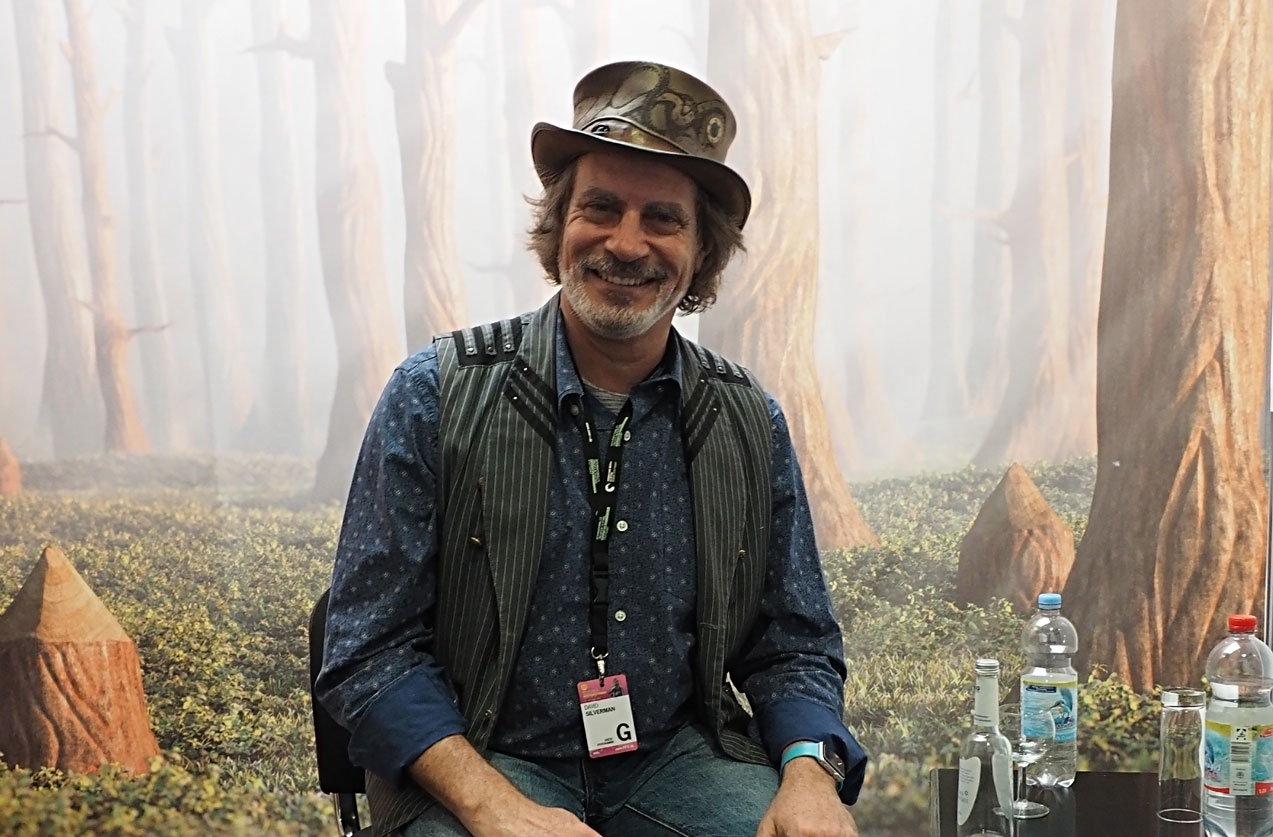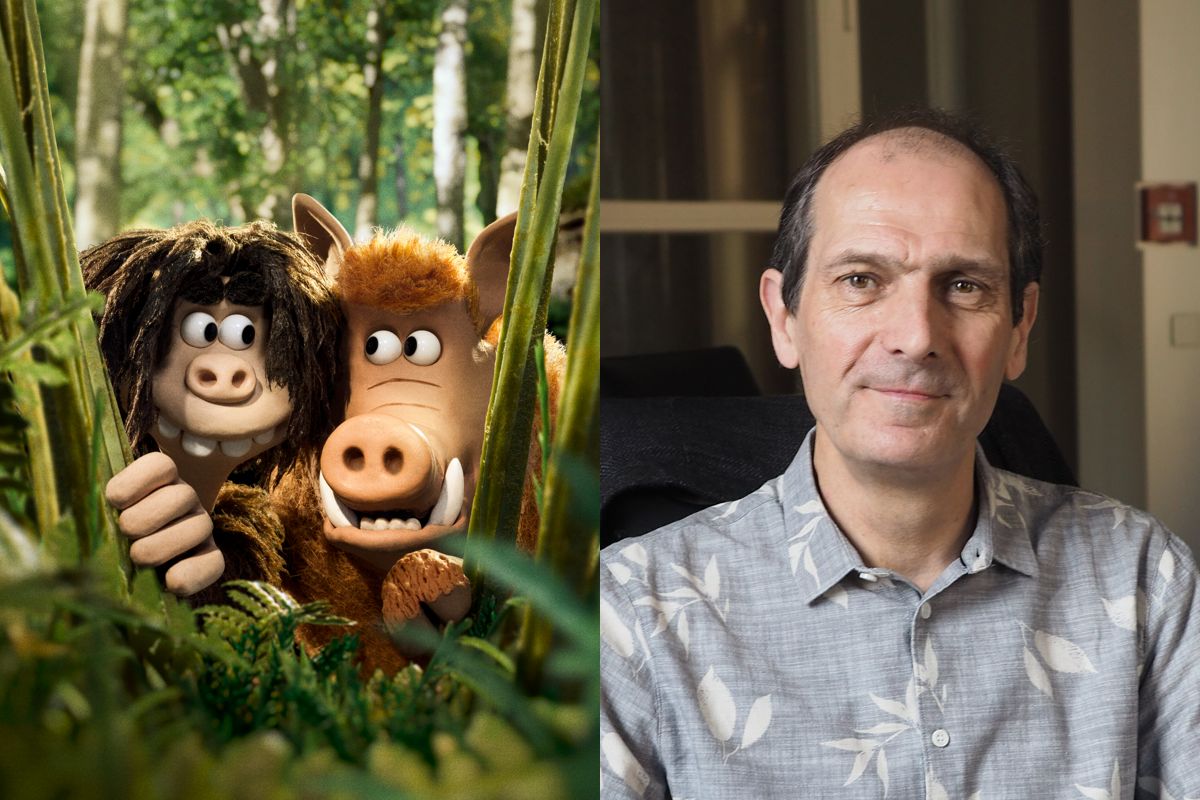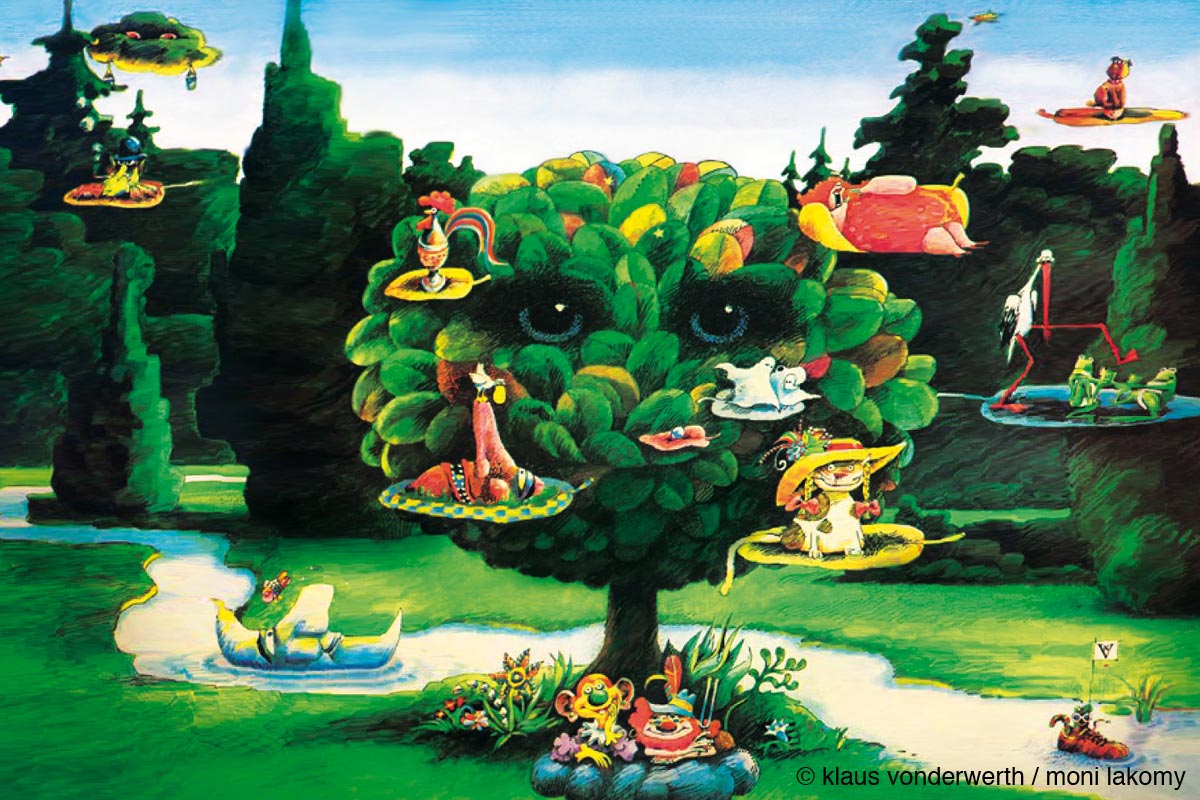The Simpsons is without a doubt one of the most well-known globally and longest-running animated American TV series in history. David Silverman has served as one of the backbones of the series, not only working as one of the major animators from the beginning, but also directing many episodes of the TV series, as well as the critically acclaimed The Simpsons Movie.
We could have a precious opportunity to interview with David Silverman in Stuttgart, Germany, during FMX 2018. He kindly told us about his ongoing long creative journey with the great animated sitcom. You can find plenty of behind-the-scenes information of The Simpsons and The Simpsons Movie. We are very happy to deliver this special interview to you.
Interview with David Silverman
Animationweek (AW): We would like to go back to the beginning of The Simpsons. How did you start work on The Simpsons?
David Silverman: When I started work on The Simpsons, I was working as a freelance animator and illustrator. Not long before I got out of UCLA in 1984, I had been going to one thing to the other freelancing. I found I was getting more illustration work than animation work, and I was beginning to consider to just stop working in animation altogether for a while and concentrate on illustrating. Not that I would quit it, but I was really thinking seriously of doing that.
I’d just finished a film called One Crazy Summer (1986) that was directed by Savage Steve Holland, and Bill Kopp directed the animation. Bill and Steve were all from CalArts. One of the other animators on that little short production was Wes Archer, who has done freelance work for Klasky Csupo, and gotten the bid, the contract if you will, for The Tracey Ullman Show (1987-1990), and we didn’t know Tracey Ullman, we haven’t heard of her before, but we had heard of Matt Groening. This came about in early of 1987 through Wes, and Wes got myself and Bill Kopp involved. I almost was not involved, because they had originally budgeted for 3 animators, and realized they didn’t have enough money for 3 animators, and so we were back down to two.
They started on March 9th, 1987, and they called me on Tuesday saying “we really need your help!”, because they were not actually starting on Matt’s work, they were starting on M.K. Brown’s work. Short-lived thing called Dr. N!Godatu (1987), and her work was much more difficult to do, so I came in and started helping out. I thought I was going to be here for two weeks to help out, but Gábor Csupó saw my work and said that it was really great, he decided that he did have enough money for three animators, because they were running over. Every second they were over, they got an extra… whatever, so they had more than enough to afford another animator, so that’s how I got involved. Ta da~! (laughs)
AW: What were the most important contributions you have made to the Simpsons series?
David Silverman: Oh, gee… I don’t like to boast! (laughs) Firstly, working with Matt Groening and Sam Simon, and later Jim Brooks, and a big group effort, did the opening title sequence design. I think I contributed a lot to the sense of performance, particularly with Homer, because I did a lot with Homer’s more gregarious performances. There was an episode called Blood Feud, and Homer had this great run of: “Marge, you’re my wife, and I love you very much, but you’re living in a world of make-believe! With flowers and bells and leprechauns, and magic frogs with funny little hats!” Dan Castellaneta went into this very funny voice reading, and I thought it was hilarious, so I just went for it. Further that we had really taken Homer, further than the animation budget seem to say that we were allowed to do, and we said “Ah screw it, we’re just going to go for it anyhow!”
Then there’s also a letter-writing scene, where Homer is sending to Mr. Burns an all-sarcastic letter, and again, that was fun acting.
So it started with that, and I started getting “Oh, could you do Homer saying you’re living in a world of make believe? Could you have Homer skipping in the Land of Chocolate?” For the Land of Chocolate sequence, I was the supervising director at this point, and I had a great deal to do with it, because I took over the boarding of it. I thought that the original board artists had something that was more or less a parody of The Sound of Music (1965), and I thought “Well, let’s not do a parody, let’s do something that some people may want to parody us for someday, so we should just do something original.”
I think a way of drawing the characters, a way of their performances, we all had something to do with it. Wes Archer certainly did. Rich Moore, when he became a director, and certainly Brad Bird, so I think I had a hand in that. They gave me a lot of credit for a lot of great things, and they love my episodes, so I ended up directing The Simpsons Movie (2007). I must’ve done something right!
Well, Jim Brooks also credits me of giving him at least the energy to make it a series. I don’t know if I gave him the idea per se, I would assume Matt had always wanted to do it. But I think if nothing else, he tends to think that I had suggested it at a party where I was pretty drunk (which is surprising that I would get drunk at a party!). Everytime he tells the story, I’m a little drunker, so I guess it makes for a funny story!
I remember saying to him that I’m glad we have a chance to do some really adult animation on a prime time show. I think I may have gone on about how there hasn’t been anything really animated on prime time since the days of The Flintstones (1960-1966). I might have suggested that this could be a series, I don’t know. But it was early on, it was actually probably at the first Tracey Ullman party, which was April 19th 1987, which was the first time The Simpsons bit aired on the show. It was three episodes into it, the first few of them had Dr. N!Godatu, the M.K. Brown stuff, then it was The Simpsons.
AW: What were the most memorable moments for you during your time at The Simpsons so far?
David Silverman: There had been some great moments. Speaking of the Land of Chocolate routine, I remember reading that script, and laughing so hard that I nearly fell out of my chair. It was just about Homer imagining himself in the Land of Chocolate, skipping after chocolate bunnies, and marshmallow trees. I guess when I read that, I saw it in my mind and I just laughed really hard. The idea of him skipping away.
After the third season, Wes Archer wanted to leave the show for a while, so he got on the loudspeaker and was basically saying his farewell, but he had his hilarious, kind of not-serious, but sarcastic rant. Wes was basically dissing everybody, but in such a hilarious way. That put me on the floor.
Matt Groening and I used to go to the New Orleans Jazz & Heritage Festival together, and we talked about an idea of The Simpsons in New Orleans, but we never got around to it. Last year in March, I pitched this idea to the show runner, Al Gene, and I had a hook on it that involved the nephew of Bleeding Gums Murphy, and Al said: “Oh that is great! When can you write it up?” And I said that I haven’t written an episode before! Al suggested that I should partner up with somebody. I said “sure”, and I got involved with Brian Kelley. It’s been very big, very popular, certainly very popular in New Orleans, but it’s been a popular episode.
AW: We would like to ask you about your career. How were you able to become a director of the series?
David Silverman: Well, it’s a very old expression, but it’s true: Luck is opportunity plus preparedness. When I had the opportunity to work on The Simpsons was on The Tracey Ullman Show, when nobody really paid attention to it. Wes Archer and I really dived in, just trying everything we could to make it good, be experimental and do weird things, and so forth. I guess we both proved ourselves. So when it came to the series, they just looked at us and asked if we can direct, and we said “Yeah, we can direct!” We were basically co-directing the shorts, and I think they knew that, so they thought: “Well, they did a good job with that, so let see what happens…” And that’s what happened. We were going to try directing, and it can either work out, or it won’t work out.
If my show didn’t come out well, they were like: “Well, if David’s show doesn’t come out, we’re going to pull the plug, and that’ll be it, and we’ll never bother with The Simpsons again as a serious show.” So it was literally all hanging on my episode. Maybe that’s why they like me… (laughs)
AW: What were the most important aspects for you when directing?
David Silverman: Well, really understanding the point of the story, and really staging with an eye on presenting the humor in the best way possible, and keeping that in mind as you go along, from point to point, sequence to sequence, and then within the sequence, within the scene, trying to keep that in mind. Occasionally, when you can, see if there’s anything that can reoccur, see if there’s anything to emphasize, story points or thematic points, or something like that. Anything that emotionally, or even physically repeat, in the story that would, not really duplicate, but somehow echo.
Especially on The Simpsons, making sure the comedy is timed and staged properly, and simple things like: Keeping everybody focused on the punchline, don’t step on the punchline with extraneous performances that drag on the punchline, don’t cut on the punchline, like I still see some people doing. But also, making sure the emotional performances reflect and support the joke, and don’t get in the way of the joke. Also, it’s about the emotion of the scene, and making sure the performances reflect that.
And also, make sure that your artist understands, because when doing something that doesn’t really work, try to express that and why it doesn’t work, so hopefully they can get some value out of it, and hopefully I get some value out of it, because I learn something new from the artist, and also in a way that I haven’t considered, and I think it’s much better. The other thing I look forward to is getting more knowledge from the people I am working with, and seeing what they have to present.
AW: We would like to ask you about the Treehouse of Horror episodes. They are quite a fun change-of-pace to the more typical episodes. So, please let us know your experience directing some of the episodes, and how you find it compares to the typical The Simpsons episodes.
David Silverman: There are always The Simpsons episodes that you can do a lot of great cinematics, particularly in Treehouse of Horror, because you’re often parodying certain films that had a signature look or have an iconic scene, something like that. It’s always fun to replicate that. But also, they’re far more difficult, because they usually involve three times the amount of design work, because each story will be very different, especially as we got along in later seasons.
There was an episode where Homer clones himself, and it wasn’t so bad, because there wasn’t a lot of design, just a lot of work with a lot of Homers. Actually, it was a pretty simpler one, and the only one that was really difficult was The Island of Dr. Hibbert, where every one of the backgrounds had to be all new, the characters all had to be redesigned, and so forth. But typically, you had three times the amount of design work.
But, they’re fun because you get to play with them and the characters get to perform in different genres, and usually one that you had some connection to, from a filmmaker’s point of view, like “Oh, this would be a great parody of Bram Stoker’s Dracula“. I know Mike Anderson had a great time parodying all these Hitchcock films, like a parody of Strangers on a Train (1951).
The one I enjoyed the most was Treehouse of Horror IV, that included the episodes The Devil and Homer Simpson, Terror at 5½ Feet and Bart Simpson’s Dracula, and the episode also had a parody of the TV show called Night Gallery (1969-1973) hosted by Rod Serling, which now nobody knows what the hell we’re talking about (laughs), but it works! The thing is that it actually works even though you don’t know what it is about. With Bart just walking through saying “paintings…”, “life is images rendered in colorful goop”, which I believe is a Conan O’Brien line. It all still works.
AW: I like to ask you now about The Simpsons Movie, which of course is such a huge thing for The Simpsons. What was your vision for the film?
David Silverman: I was trying to get it done on time. That was my vision! (laughs)
It was interesting because I was more involved with the story on that, more than the show, because Jim Brooks wanted me to be in the rewrite room, for nothing else than if something were to pop into my mind. I would say this: I wanted to do something in widescreen, in 2.39, which is CinemaScope widescreen. At the time, the show was on 1.33 aperture, 4:3 ratio, and so that’s what inspired me. I remember looking at older CinemaScope films because they were very beautifully staged. I needed something that had a lot of characters in it, because there were often a lot of characters on the screen. I particularly looked at Bad Day at Black Rock (1955), because that was one of the great John Sturges, well-staged. It was almost like a play, very interesting compositions of characters. I looked at Lawrence of Arabia (1962) again. I also looked at It’s a Mad Mad Mad Mad World (1963), because that was a comedy that often had ten people on the screen at the same time. And often shot in a proscenium way to present everybody. I thought that was a very useful thing to look at.
So that was where I started from, keeping an eye on making it much more cinematic than we do on the show, keeping every shot had to be cinematic basically. In the show, you try your best to render every shot with a great deal of attention, but there’s only so much time. I at least pick my main shots in an episode, thinking these have to really work, and I can let the other ones just be the service to do the job, because you don’t have the time. If these work, then everything else will work, high tide floats all boats. But with the movie, every shot had to be awesome, so that was the other consideration.
We were moving so fast, so I had sequence directors working underneath me and working with me, really, and so that took a lot of the pressure off too. We started boarding in the beginning of 2006, and we had to stop, all pencils down, at the beginning of June, 2007. That’s not a lot of time, it’s a little less than a year and a half, to do the film from board to color.
AW: How did you find the transition from directing an episodic series to directing a movie?
David Silverman: I think it’s just communicating with everybody. There was also the challenge in logistics, because we had two studios in LA working on it, Film Roman and Rough Draft Studios, so that was hard. We also had a group working on the Gracie Films lot, doing the main storyboarding, just so they can react fast, with great nimbleness, to Jim Brooks and Al Gene with what they wanted to change at a drop of a hat. So I had to spend a lot of time at three locations, and that got to be grueling. I ended up spending more time in the trailer at the Fox lot, because that was where the main work was happening, in terms of getting the story finished and getting the boards right.
Once I got the boards right, the staging was set up with the boards, I could work with the sequence directors and pass that stuff off to them and they would re-board it, and I would see that, and so forth. But that was the challenge, it was the logistics. And also the ticking clock!
AW: As a long-time The Simpsons fans, we felt that the movie was very extraordinary. How did you make The Simpsons Movie feel so special?
David Silverman: I really felt like we dodged a bullet. We were really worried that it wasn’t going to work somehow. We were hoping that it was going to work out, but it was very difficult to do. It was harder than we thought to make a movie out of this show. The format of this show is different to the format of the movie. Even Jim Brooks, who had experience in movies, found that it was a real challenge. But we were just happy when the crowd reacted as well as they did. We have this publicist who was in charge of Fox publicity, and he was just like: “Guys, don’t worry, this film is hilarious. I can make a trailer, and I guarantee that every time I get a laugh from a trailer, it’s an extra $10 million at the weekend box office.” And he was right! We had a huge weekend opening, almost by his prediction.
AW: You have worked on some projects unrelated to The Simpsons. What were the biggest things you have taken away from The Simpsons that have influenced you?
David Silverman: I think, if I were to bring anything to the other projects I did, it would be a little bit of The Simpsons sensibility and The Simpsons sense of humor. The throwaway sense of humor, the unexpected line of dialogue. I don’t know if it’s true or not, but I like the sense of performance, because we try to go for a real and honest performance. Matt Groening really wants us to avoid the cliché cartoony poses that people don’t really do, like pointing up in the air, which I always call “Cartoon Vaudeville”, and I would try to say: “Be aware of Cartoon Vaudeville poses! Have somebody do something different with their hands”. You should try doing something subtly different with the finger and hand posing, something that has a more sense of humanity, not just sense of cartoon, with all the moving-around.
It’s probably that, which is what I take away the most from The Simpsons.





